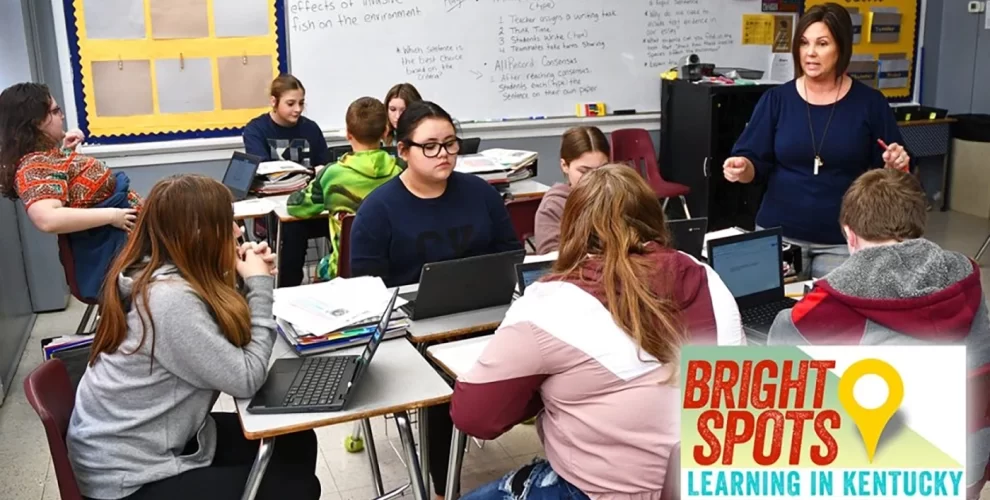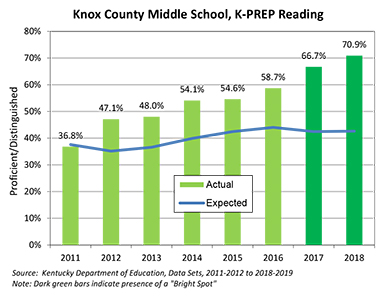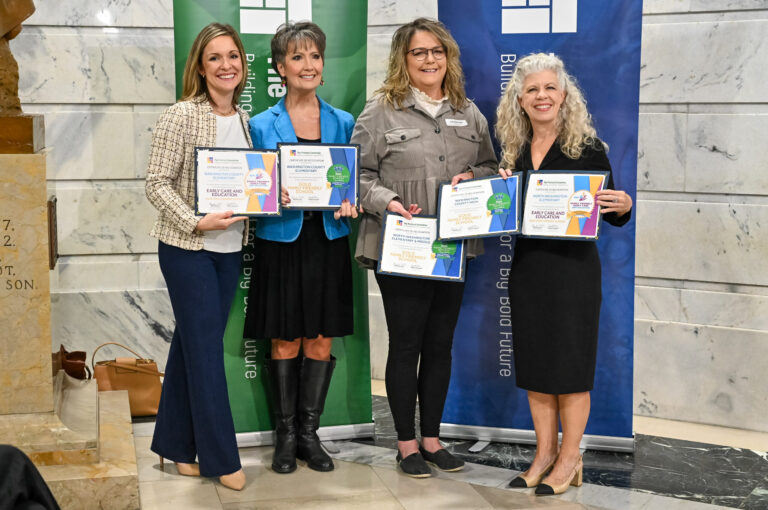ASSURING STANDARDS REACH STUDENTS FUELS IMPROVEMENT

MAY 2022 \ KNOX COUNTY MIDDLE SCHOOLThings get heavy in seventh-grade math. Knox County teacher Bethany Miracle explains: From the concrete fundamentals of arithmetic, students begin to tackle unknowns of algebra and principles of geometry and statistics as the subject launches into abstract ideas.In a two-year middle school where seventh- and eighth-grade students are making transitions to more complicated ideas across several subjects, she said an important key for stronger student learning grew from providing more opportunities to understand classroom concepts and demonstrate mastery.Miracle said that new opportunities to try again dramatically reduced the number of students falling behind.“By becoming able to teach in different ways until students got it, we basically eliminated the possibility of failing,” Miracle said. The school worked to remove the stigma for trying again for both students and teachers by emphasizing improved performance. “We showed that we do whatever it takes to get them where they need to be,” she said.This year — emerging from two school years dominated by pandemic closings, re-openings and modifications — the Knox County district embarked on a plan to significantly increase student learning by adding structure to how it covers and assesses academic standards. Last year, the principal who led the middle school turnaround was named superintendent.Now, as some Kentucky districts scramble for paths to rebound from COVID learning gaps, Knox County is working to improve delivery of grade-level content and create new ways for students to catch up.Superintendent Jeremy Ledford, a Knox County native, said that creating multiple chances to grasp academic concepts became an important change in how educators, students, and families defined academic success.“We like to say that kids are held accountable by grades, but are they really?” he asked. Poor grades can be a sign that a school has bypassed an important opportunity to provide extra help as much as signaling a failure by students. “When you take a new approach with kids who might have fallen through the cracks, it’s amazing what you can move them to accomplish. They will run through a wall if you believe in them.”GROUPS OF STUDENTS at Jesse D. Lay Elementary in Knox County built and recorded how high they could stack towers of cookies before they collapsed. The resulting set of data was used in math class to calculate concepts like median, mode, average and more.At Knox County Middle, the more intentional effort to build student proficiency clearly showed in a 2020 report by the Center for Business and Economic Research at the University of Kentucky. The analysis, funded by the Prichard Committee, used state school testing data filtered by local demographics to highlight schools that outperformed expected academic results over eight years of results. Of more than 400 middle schools statewide, only 4 emerged as “Bright Spot” schools.

SOURCE: Center for Business and Economic Research report “Kentucky Public Schools as Educational Bright Spots,” 2020.Knox Middle, a 425-student school where 86 percent of students are considered economically disadvantaged, made the list for reading results, math results, and multi-year achievement. In each category, the school showed statistically significant over-performance by the entire student population (See charts, left.) as well as by students from low-income families and by students with disabilities. The report noted that the overall student population beat expectations by 20 percentage points. The school more than doubled proficiency rates in math from 2011-12 to 2018-19, according to the analysis.Miracle, a Knox Middle math teacher, said that changes starting in 2015 improved the work of teachers while leading more students to master academic standards.

“I reflected a lot more on my teaching” after the school started re-teaching concepts to students when they couldn’t score better than 70 percent on quizzes or activities to gauge what they had learned. “As a teacher, we were taught strategies for instruction and how to implement them, but we were never really taught what to do if that didn’t work,” Miracle said. “We had been letting students who were already behind fall more behind.”Teachers said that in addition to restructuring the school day and assessment strategies, they worked to build stronger relationships with students so that re-teaching was not seen as a punishment but a way to deliver something students needed. Similar outreach was used to build parent confidence in the move to a dedicated, 55-minute class period daily.Students were assigned to the class day-by-day, as needed. What became known as “Panther Time,” named for the school’s mascot, was billed as something every student should expect at some point each year.
By becoming able to teach in different ways until students got it, we basically eliminated the possibility of failing.
— Teacher Bethany Miracle
“We saw it as just as important as a content-area class,” said Superintendent Ledford. “It had to be.” As the strategy took hold, the number in re-teaching classes grew smaller as students and teachers alike realized how to make better use of class time and gain more during the review time, he said. The school also added in-school tutoring time plus after-school tutoring to expand opportunities for students to surpass the 70 percent minimum competency mark.As Knox Middle continues to refine academic supports, the district this year launched a new effort to adopt common curriculum pacing plans at its seven elementary schools — adding definition to when and for how long academic concepts will be covered. Panels of teachers created the plans for this school year and will revise them over the summer.Ledford said that the clearer structure should not only set a foundation for meeting academic goals with younger students, but also better serve students who change schools within the district. The framework for covering academic content also aims to help a growing number of teachers pursuing an alternate pathway to certification.Beyond a detailed plan, the district is providing feedback from regular classroom visits at each school about how standards are covered and met in classrooms.“We talk about being a system that can take students where they are and move them where they need to be,” said Sheila Terrell, the director of elementary education who previously served as assistant principal at Knox Middle. “At the elementary level, every one of our schools needs to be that — providing teachers that you trust in place where people can say it doesn’t matter what school your child goes to.”
When you take a new approach with kids who might have fallen through the cracks, it’s amazing what you can move them to accomplish.
— Superintendent Jeremy Ledford
Frank Shelton, the district’s communication director, said the focus districtwide promotes intentional teaching and learning, monitoring outcomes, and building buy-in. Underlying all of those goals, he added, has been recognizing the strengths and needs of students and maintaining solid connections with families. “We want to know the background story behind our students and see beyond test scores — what matters to that actual student,” Shelton said.“Being able to feel that sense of family,” he added, is essential to creating a culture where failure is not an option and success is the norm. “The student feels more supported and more likely to seek help and generally perform better knowing that they are in a safe learning environment that allows for overcoming initial mistakes.”“I feel like we’re on the right track,” noted Tiffany Loveless, a Knox County native and 17-year teacher at Jesse D. Lay Elementary in Barbourville. “There’s a lot of people on board.”Loveless said that the district’s improvement efforts are taking hold as the educators are grappling with major COVID upheaval, but the changes have brought systems and direction that make sense to teachers.“I don’t feel like they’ve put anything on my plate that’s pointless,” Loveless said. “It’s very structured, and that’s what we like.”She was part of the team that drafted the fifth grade curriculum pacing guide and explained that the process has opened new lines of communications among teachers in the county and inside schools. As the school year reached its end, she said that the return to normalcy as COVID subsided and ambitious steps by the district to boost teaching and learning feel “refreshing.”“What’s happening here really does have what is in the best interest of kids at its heart, and that’s what we need,” said Loveless. “Teacher’s voices are heard and the communication is there. That’s what we need. People like to see that kind of change big time.”STUDENTS AT JESSE D. LAY ELEMENTARY discuss their calculations from a data set during a sixth-grade math lesson.TOP PHOTO: STUDENTS IN AN ENGLISH CLASS at Knox County Middle School discuss facts about invasive fish as part of a persuasive writing assignment. Teacher Shelley Jenkins answers questions from a group of students.




